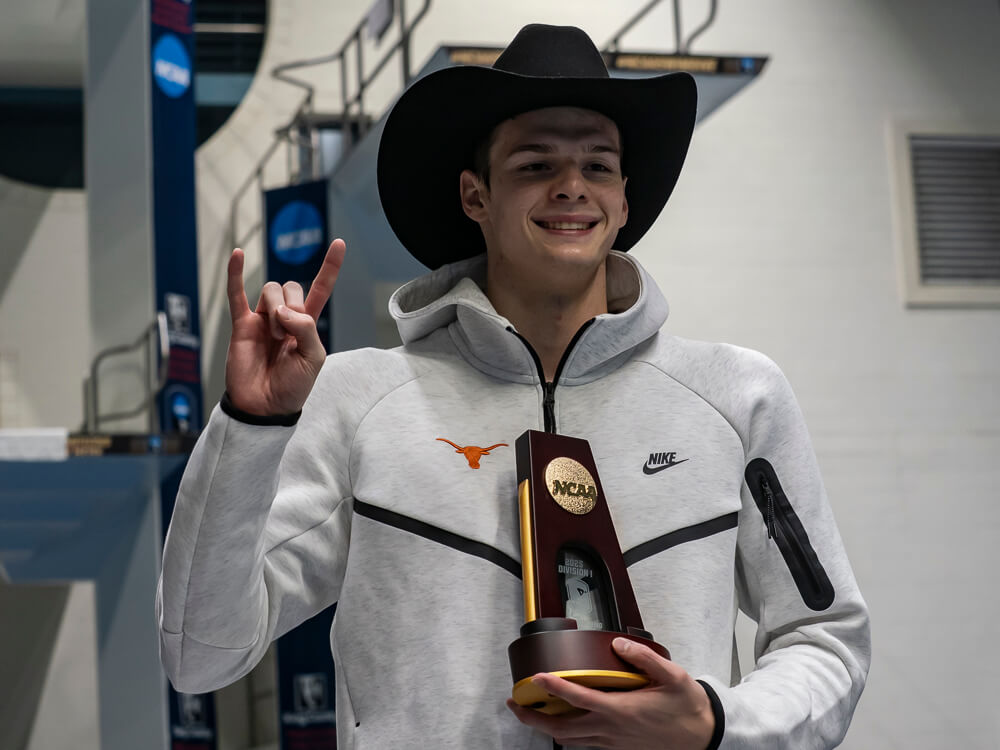Hubert Kos, Torri Huske, Claire Curzan Have Decisions to Make After NCAA Schedule Change
Over the past several years, Hubert Kos and Torri Huske have established themselves securely among the world’s best swimmers, both having secured individual Olympic gold medals in Paris along with numerous other international medals before the end of their college careers. Claire Curzan is another current NCAA swimmer with a record of strong international achievement.
Three of the best current college swimmers and all with major decisions to make regarding their event lineups for this year’s NCAA Championships. The newly-adopted lineup of events creates conflicts for all three, virtually ruling out a repeat of the event programs they swam at the last edition of the meet in 2025. Individual success is on the line as well as team points; Curzan (Virginia) and Kos (Texas) are the leading returning scorers for the defending national champions while the Stanford women have big goals for Huske’s final year of eligibility.
Last season, Kos captured NCAA titles in the 200 IM, 100 backstroke and 200 backstroke. Now, with the 200 IM moved to the meet’s final day, he will almost certainly have to drop that event from his schedule to focus on his premier race, the one in which he swam the fastest time ever by more than a second in 2025. The new NCAA order of events projects an 81-minute finals session, meaning the 200 IM and 200 back finals would take place less than an hour apart. That is a big ask, even for a swimmer as accomplished as this Hungarian star.
If Kos indeed drops the 200 IM from his slate, he would be looking for another race, likely one of the individual races held Thursday. Kos is an accomplished 100 butterflyer, presenting that event as a natural option, and he did handle butterfly duties on both of Texas’ medley relays at last season’s NCAA Championships. On the 400 medley relay, Kos split 43.45, an exceptional time but behind the marks of Florida’s Josh Liendo, Arizona State’s Ilya Kharun, Georgia’s Luca Urlando and Cal’s Dare Rose, three of whom (all except Rose) will be back this year.
The new event lineup hurts Kos, and it would have been problematic for other standouts with skills in both the 200 IM and 200 back. Before Kos, the likes of Ryan Lochte (2005 and 2006), Missy Franklin (2015), Kathleen Baker (2017), Beata Nelson (2019), Shaine Casas (2021) and Destin Lasco (2024) won titles in both events at the same meet. Meanwhile, the 200 IM-200 fly double becomes even more impractical. It has been a long time since a male swimmer swept both events, but venerable females such as Katinka Hosszu (2011), Ella Eastin (2018) and Alex Walsh (2022) got wins in both events under the familiar old lineup.
Torri Huske — Photo Courtesy: Peter H. Bick
Moving to mostly shorter races, the conflict for Huske would come on the final day of the women’s meet, with the 200 IM and 100 freestyle now scheduled to take place back-to-back. Last season, Huske took down Walsh for the NCAA crown in the 200 IM while also taking second behind Gretchen Walsh in the 100 free. Fortunately for Huske, the decision might not be too hard to make: she will likely drop the medley and pick up the 50 free, set for a day (Friday) when none of Huske’s other main events are held.
With the younger Walsh sister’s days of dominating the college sprints now concluded, Huske would be the significant favorite for national titles in both sprint freestyle races as well as the 100 fly. The switch would work out for Stanford as well; five of the eight swimmer’s in last year’s NCAA final of the 200 IM were in their final year of collegiate eligibility, and Huske’s withdrawal from the event would leave Stanford teammates Caroline Bricker and Lucy Bell as the only returning A-finalists.
Curzan’s event decision is probably a lower-stakes one given the depth of talent returning to the Cavaliers’ roster this season and the clarity of the events in which she is a true national contender. The backstroke events are now central to Curzan’s slate, and she is the reigning NCAA champion in the 100 and 200-yard races. She will surely swim both in 2026. The 50 free, however, is in question since it takes place the same day as the 100 back.
Curzan was second to Gretchen Walsh in the splash-and-dash last season, so she would be the top returning finisher, but the likely presence of Huske in that event complicates the situation. If Curzan raced the 50 free, she would enter fatigued in a likely-competitive final and the 400 medley relay still to come later in the session. Alternately, she could switch to the 100 fly, held on a day when she has no other individual races, and likely finish second behind Huske.
As for other multi-event stars returning to the college ranks, the new schedule works out much better. Liendo can continue racing the 100 fly plus the 50 and 100 free, all events in which he has won multiple times, with no conflicts. Kharun remains in good shape for the 50 free plus both butterfly events. Swimmers can continue racing the 200 IM and 200 breaststroke plus either the 400 IM or 100 breast. Leon Marchand would have faced no event conflicts during his incredible three years of NCAA racing.
Still, Kos, Huske and Curzan join dozens of swimmers facing key choices for the NCAA Championships and hundreds more with the same dilemmas for their conference meets, which typically mimic the format of the national competition. Coaches have long known changes to the national meet format were imminent, but now they have only a few months to adjust training as necessary and ensure their athletes are prepared for a different-looking championship season.
